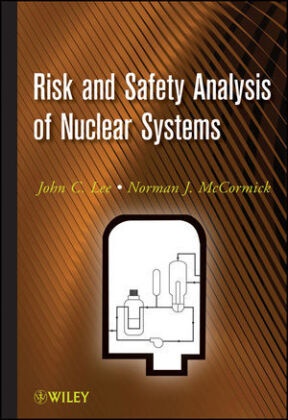Read more
Informationen zum Autor JOHN C. LEE, PhD, has been Professor of Nuclear Engineering at the University of Michigan since 1974, following five years of employment at Westinghouse Electric Corporation and General Electric Company. He has written for approximately 180 publications on broad areas of nuclear reactor physics and engineering, including nuclear systems analysis and diagnostics. Dr. Lee is a Fellow of the American Nuclear Society. NORMAN J. McCORMICK, PhD, is an emeritus professor of mechanical engineering at the University of Washington who retired in 2003. From 1966 until the early 1990s, he was a professor of nuclear engineering. Dr. McCormick is the author of the book Reliability and Risk Analysis Methods and Nuclear Power Applications (upon which part of NERS 462 is based) and has authored approximately 150 journal articles. He is a Fellow of the American Nuclear Society. Klappentext An authoritative guide to enhancing the safety, reliability, and availability of nuclear energy systems The catastrophic events of March 2011 in Japan serve to remind the next generation of nuclear professionals that a nuclear accident anywhere is a nuclear accident everywhere. This timely resource provides a necessary introduction to risk and reliability assessment as well as an overview of nuclear power plant safety analysis, augmented by real-world examples drawn from design and operating experience. Developed in conjunction with Nuclear Engineering and Radiological Sciences (NERS) 462, a course offered every year to seniors and graduate students in the University of Michigan NERS program, this book is needed more than ever, as nuclear power is once again becoming a viable option for new electrical generation facilities. The first half of the book covers the principles of risk and reliability analysis, the techniques used to develop and update a reliability database, the reliability of multi-component systems, and Markov methods used to analyze the unavailability of a system with repairs. The second half covers applications of the methods for probabilistic risk assessment of complex engineered systems, together with deterministic safety analysis of nuclear power plants. Also featured are: Fault trees and event trees used in probabilistic risk assessments Failure modes of systems A review of major accidents and incidents in commercial nuclear plants over the past three decades Passive safety features of advanced nuclear systems that are under development Advanced topics such as dynamic event tree analysis and binary decision diagrams for fault tree evaluation Approaches taken for risk-informed regulations for nuclear plants More than sixty solved examples and more than 140 exercises Presenting synergistic coverage of both probabilistic and deterministic risk assessment techniques for nuclear systems, this text is invaluable for advanced undergraduate students in nuclear engineering, first-year graduate students, and practicing engineers in the area of risk and reliability assessment, particularly those in the nuclear industry. Zusammenfassung After a multi-decade hiatus, it appears that nuclear power again may become a viable option for new electrical generation facilities in the United States. Due to regulations, every utility that operates a nuclear power plant will require risk and reliability assessment. Inhaltsverzeichnis Preface xii Permissions and Copyrights xiv List of Tables xvi List of Figures xviii 1 Risk and Safety of Engineered Systems 1 1.1 Risk and Its Perception and Acceptance 1 1.2 Overview of Risk and Safety Analysis 6 1.3 Two Historical Reactor Accidents 8 1.4 Definition of Risk 9 1.5 Reliability, Availability, Maintainability, and Safety 10 1.6 Organization of the Book 12 References 13 2 Probabilities of Even...
List of contents
Preface.
1 Risk and safety of engineered systems.
1.1 Risk and its perception and acceptance.
1.2 Overview of risk and safety analysis.
1.3 Two historical reactor accidents.
1.4 Definition of risk.
1.5 Reliability, availability, maintainability, and safety.
1.6 Organization of the book.
2 Probabilities of events.
2.1 Events.
2.2 Even tree analysis and minimal cut sets.
2.3 Probabilities.
2.4 Time-independent versus time-dependent probabilities.
2.5 Time-independent probabilities.
2.6 Normal distribution.
2.7 Reliability functions.
2.8 Time-dependent probability distributions.
2.9 Extreme-value probability distributions.
2.10 Probability models for failure analyses.
Exercises.
3 Reliability data.
3.1 Estimation theory.
3.2 Bayesian updating of data.
3.3 Central limit theorem and hypothesis testing.
3.4 Reliability quantification.
Exercises.
4 Reliability of multiple-component systems.
4.1 Series and active-parallel systems.
4.2 Systems with standby components.
4.3 Decomposition analysis.
4.4 Signal flow graph analysis.
4.5 Cut set analysis.
Exercises.
5 Availability and reliability of systems with repair.
5.1 Introduction.
5.2 Markov method.
5.3 Availability analyses.
5.4 Reliability analyses.
5.5 Additional capabilities of Markov models.
Exercises.
6 Probabilistic risk assessment.
6.1 Failure modes.
6.2 Classification of failure events.
6.3 Failure data.
6.4 Combination of failures and consequences.
6.5 Fault tree analysis.
6.6 Master logic diagram.
6.7 Uncertainty and importance analysis.
Exercises.
7 PRA computer programs.
7.1 Fault tree methodology of the SAPHIRE code.
7.2 Fault and event reevaluation with the SAPHIRE code.
7.3 Other features of the SAPHIRE code.
7.4 Other PRA codes.
7.5 Binary decision diagram algorithm.
Exercises.
8 Nuclear power plant safety analysis.
8.1 Engineered safety features of nuclear plants.
8.2 Accident classification and general design goals.
8.3 Design basis accident: large break LOCA.
8.4 Severe (Class 9) accidents.
8.5 Anticipated transients without scram.
8.6 Radiological source and atmospheric dispersion.
8.7 Biological effects of radiation exposure.
Exercises.
9 Nuclear power plant accidents and incidents.
9.1 Three Mile Island Unit 2 accident.
9.2 PWR in-vessel accident progression.
9.3 Chernobyl accident.
9.4 Salem anticipated transient without scram.
9.5 LaSalle transient event.
9.6 Davis-Besse potential LOCA event.
Exercises.
10 PRA studies of nuclear power plants.
10.1 WASH-1400 Reactor Safety Study.
10.2 NUREG-1150 assessment of severe accident risks.
10.3 Simplified PRA in the structure of NUREG-1150.
Exercises.
11 Passive safety and advanced nuclear systems.
11.1 Passive safety demonstration tests at EBR-II.
11.2 Safety characteristics of Generation III+ plants.
11.3 Generation IV nuclear power plants.
Exercises.
12 Risk-informed regulations and maintenance.
12.1 Risk measures for nuclear plant regulations.

